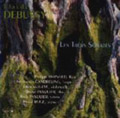Recommendable
Discs |

     |
"Les Trois Sonates :
Sonate pour Flûte, alto et Harpe / Sonate pour Violon et Piano / Sonate pour Violoncelle et Piano" (Accord: 205152)
Pascal Roge (p) Pascal Bernold (fl) Bruno Pasquier (vla) Frédérique
Cambreling (hrp) Régis Pasquier (vln) François Guye (vc)
Maybe because himself is a pianist, Debussy did not compose many chamber
works. But he made 3 sonatas quickly in his last days. This CD conveniently
compiles them. Although the fame of this disc is not so large as the recordings
of old giants (such as Laskine, Rampal and Pasquier's recording for Erato),
the contents are extremely nice (thanks to the best performers of the days
in France when this recording made). Above all, the achievement of Rogé
as accompanist throughout this recording is marvelous. I am sure that his
ability as an accompanist is much greater than a soloist. The present tendency
to regard accompanist as being inferior to soloist is tragic misunderstanding.
They require different ability. As for the harp sonata is performed by
less (generally) known musicians. However, in fact, they are all undoubtfully
the masters. The harpist obtained the first prize in Paris Conservatory
and was appointed as a solo harpist of National Orchestra of France. Also,
Mr.Bernold was the principal flutist of Lyon Orch. and Mr.Cambreling was
principal viola of France National Orch.. Their French-rooted interpretation
(sounds like the ancient Greek court ladies lying on a field with smiling)
are really gentle and soft. Above all, the interpretation of the first
movement clearly demonstrates their natural dominance. There is no recording
which can catch the nuance of the archaic atmosphere better. |

     |
"Introduction et Allegro (Ravel) Conte Fantastique / Deux Divertissements
(Caplet) Sonate pour Flûte, Alto et Harpe (Debussy)" (Claves
: CD 50-280)
Ursula Holliger (hrp) Peter-Lukas Graf (fl) Serge Collot (vla) Hans Rudolf
Stalder (cl) Die Kammermusiker Zürich
Unexpectedly, the date when this instrument - harp - became to attract
the modern French composers' attention was fairly new. It is owing to the
newly reformed 'chromatic harp' from a company, Erard in 1894. By increasing
the quantity of the strings, they can be tuned in chromatic tonality. Then,
the potentiality of this instrument was raised dramatically. It is needless
to say that the sound is initially attractive for modern composers, so
that they started to explore the possibility of the instrument. Imagine!
Even though you can easily recall the younger composers when you asked
to examplify the modern composers made masterpieces for harp, you will
come to notice the fact that it is difficult to recollect many modern composers
from older generation (e.g. from Franckists or senior members of Roman
Prize referee). Isn't it interesting for you? Yes, the instrument played
a important role to distinguish the generations of the belle epoch! This
CD compiles the works by 3 representative composers of the newer generation.
Including Ms.Holliger (who has studied in Basel and Brussel Conservatory),
the performers are Swiss-centric except the viola (he is a member of Parrenin
Quartet). The performence clearly reflects their nationality. Comparing
to the French disc indicated above, the feature is tight. Also, the tempo
is faster than the French one. Although the performance does not contain
soft atmosphere or nuance, this is still favorable because of its faithful
and strict appearance such that they do not omit any detail. Their virture
can be heard especially in the second movement. |
The 5 star-ratings are for 'Sonates' only
|


